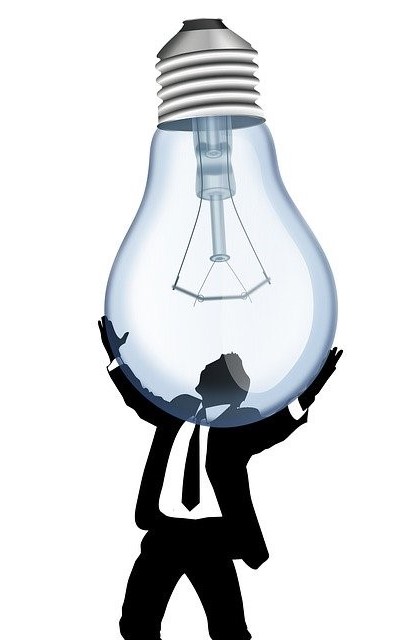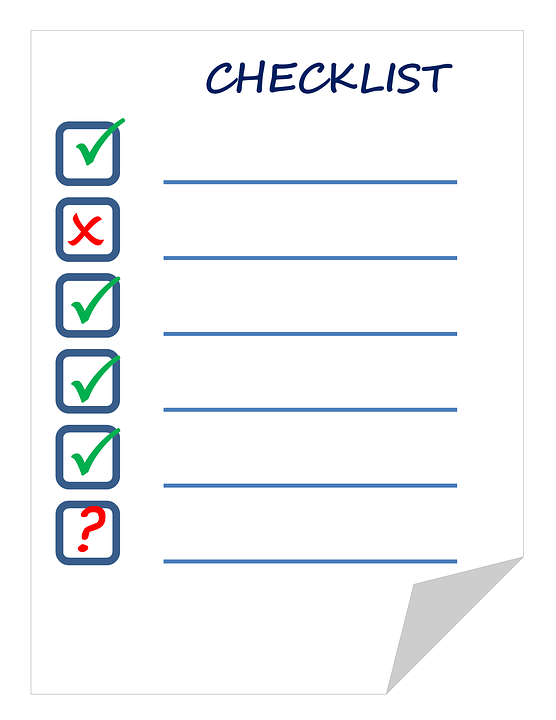Reading time: 5 minutes

File:Corporate_Woman_Giving_a_Power
Point_Presentation.svg
WORKING METHODS Some love it, some hate it. But you should become more comfortable with lectures, because they are not only one of the most important methods in school life, but also play an important role in professional life. This makes a proper preparation and a good presentation even more important.
I love giving lectures because with the right preparation you can easily get a good grade. Of course there is a lot of work behind it. But I believe I have found the right approach for me to work as effectively and time-saving as possible.
Note: If this is a group work, you will find more tips specifically for working together here. If you are giving a presentation on your own, ignore this tip.
1 In the beginning there is the topic

You can choose your own topic? Great! Think carefully about what you are interested in and if you feel able to explain this topic to others. If the topic is already given – also fine. Then you don’t have to think about it yourself, but can start right away to spice up the lecture, which may sound boring at first.
The best way to do this is to think about what you want to achieve with your lecture:
- What are the main messages I want to make clear? Is there perhaps a guiding question I need to answer?
- Should I just inform the others about the topic? Do I want to interest them or even encourage them to discuss it? Or do I want to appeal to them?
2 Defining the framework
Before you start gathering information, you should set the framework for the presentation. Therefore you have to ask yourself: How do I want to get my topic across? How do I best achieve the goal I have set myself?
Please note: These are only rough preliminary considerations which you will build on later, but which can still be changed during the course of the lecture.
- Timing: Usually this condition is already set by your teacher. The whole further arrangement depends on whether it is a short lecture of 10 minutes or a 60-minute presentation.
- Rough outline: Based on the time you want to fill in, think about how you can structure your presentation in order to present the main statements as well as possible. Don’t go too small steps. Start with a very general structure, for example 1. Biography of Bach 2. Musical characteristics 3. Example piece etc.
- Illustrative material: Now think about how you can illustrate what has been said. Basically, the longer your presentation is, the more interesting you must to present the information. For a short lecture, single pictures (caution: not too small and in a NY case with a reference!) or a poster are usually sufficient. For longer presentations PowerPoint or OpenOffice presentations are suitable.
In addition, you can also work with handouts that summarize the most important information briefly and concisely – possibly also in connection with pictures. A presentation can also be given a bit of pep by integrating a short video, for example as an introduction. But this should be used with care. It is not suitable for short lectures and should generally not be too long, since the main focus is of course on what you say yourself. - Involving the students: Finally, it is important to know what role the audience should play in your presentation. Do you simply want to speak the whole time while your classmates sit and listen or should they actively participate in the conversation?
Again, the importance of interaction with the students increases with the length of the talk. By incorporating tasks that require the students to deal with one of your sub-topics themselves, the knowledge conveyed is retained longer. A quiz at the end has the same effect and additionally checks whether your audience has understood the most important information.

3 Collection and processing of information
This is the most important and, in my opinion, most exciting part of your preparation: collecting and organizing information. It is advisable to exploit the content using one main source of information (perhaps this source is already given by the teacher) and to use other sources only for further information.
If you feel confident in the topic you are presenting, you can instead draw information from all sources of information equally and put them together to form a whole, like in a big puzzle. But this requires a high degree of structure and a lot of background knowledge.
Make sure to use different sources of information, e.g. to get away from Wikipedia and alternatively work with a book. But caution is required everywhere, because not everything that is told must also be true or it is strongly subjective.
If you think you have noted down all the important information (including the sources you used), you have to arrange it, process it and summarize it into key points (no sentences!). This is where your rough outline comes into play again. With your hopefully now extensive knowledge you can complete it and fill it up with subtopics. This is what you orientate yourself on when you build up your key points.
4 Structure of the lecture
In order to make your presentation presentable now, you have to put your key points in a nice frame and add illustrative material.
First of all, choose a good introduction for your presentation, such as a quotation or a question that fits the topic, with which you can open the lecture and which will attract the attention of the audience or, in the best case, interest them in your lecture. To keep the content flowing during the presentation, it is also worthwhile to find suitable transitions from one subtopic to the next.
To round off your presentation perfectly, your conclusion should contain both a reference to the beginning and the conclusion/answer to the main question. Make sure that your illustrative material only makes the presentation more interesting, but does not put it in the background, e.g. that it contains as little text as possible. This is not the problem with pictures if they contain little text except for a short subtitle.
Even if you decide to use a poster, it is important to keep the descriptions to a minimum. For PowerPoint or OpenOffice presentations this tip is more important than ever. So don’t just write down your key points, but keep it short and focus on pictures, videos or even audio files instead. Presentations consisting only of pictures are also okay. If you work with a handout, all the information that is important for the students can be found there.
Tip: You will soon find more detailed descriptions of how to create PowerPoint presentations, handouts, … in separate articles in my blog.
5. Assembling and checking all parts

You think you have worked all the points of your framework off? Congratulations! To be sure that your presentation will be perfect after so much work, it is advisable to talk everything through again and check it with the following checklist:
- Do you stay within the time limit?
- Are the key points packed into a nice frame and sound fluent?
- Does the illustrative material fit without pushing itself too much into the foreground?
- Do you have enough opportunities to respond to your classmates so that they are not bored and take as much as possible with them?
- And last but not least: Have you noted all necessary references?
Tips and tricks
Finally, a few tricks follow, which make my development process visibly easier.
- Start early enough!: Especially with more extensive lectures you should start as early as possible with the preparations, because at the beginning you can never estimate exactly how long the elaboration will take. In this way, you save yourself unnecessary stress, which will improve the quality of your presentation.
- Really get into the topic: Your presentation is only good if you know what you’re talking about. Look up necessary technical terms, and rephrase all descriptions that the normal student does not understand. The additional knowledge will not only improve your grade, but also save you from uncomfortable silence when students or teachers ask questions about your topic.
- Save your key points digitally: If it is technically possible for you to work with Word or another writing program, it is always a good idea to note your key points there. This way you keep an overview and can quickly change the structure of your notes, and you don’t risk not being able to find your notes again because they are saved on your hard disk. But for the lecture itself you should have your key points handwritten.
- Always write down the sources first: To prevent the sources from growing too big for you, it is worthwhile to create a list of sources right at the beginning and to write down all sources together with the information. This will save you unnecessary searching at the end.
Now you know everything you need to know and can prepare your perfect lecture with a clear conscience. Or do you know any other tips for preparing lectures? Get in touch with me and I will include them in the article!
Importance of the presentation

After 5 hours of elaboration you are sitting in front of a pile of notes. Your presentation is perfectly prepared. But you are still afraid of the presentation. Because you know: How the presentation of your lecture is perceived by the audience does not only depend on the content of your lecture. If you don’t present your knowledge adequately, the preparation was for nothing.
In the end, only what you present will be evaluated and not what is written on your key point cards or in your head. To prevent this from happening, I have put together some tips and tricks for the perfect presentation of lectures as well.
1. Before your presentation
Become aware of your goal! Is it just the good grade or do you want to move your audience to something? Have you thought of an exciting introduction? With these thoughts in the back of your mind, talk through your presentation several times – with and without the inclusion of illustrative material. Ideally, you will now know your key points and the respective movement sequences almost by heart. If you want to work with a beamer, etc., you should also think about how to get along with the technique you need or look for someone from the audience to help you in an emergency.
2. During your presentation

Did you know that the content of your presentation is only 10% of the total effect? Of course, especially for the teacher, what you say plays a big role. After all, he wants to see how hard you’ve worked in the topic. Also the students should of course take something from your presentation with them. But we all know ourselves that as a listener, especially when hearing difficult content, you tend to switch off quickly.
To avoid this, you need to know how to use your voice correctly. This makes up 40% of the effect. To be honest: Who wants to listen to a lecture that is monotonous and boring? No matter how good the illustrative material is. Play with your intonation. Of course, don’t exaggerate, you don’t want to put on a play. Imagine that you would tell a good friend something interesting: Speak loudly and confidently, not too slow and not too fast.
Even if you are excited and stutter a little at first, don’t worry. This happens to everyone and will give in after a minute or two. Nevertheless, try to avoid frequent “Um…”, “Well…”, etc. Swallow it and instead take a break and a deep breath. In short: if you speak in a relaxed and friendly manner, nothing can really go wrong. The same applies to the most important point of your presentation: your body language with 50% of the total effect. If you seem insecure, it looks like you have not prepared yourself well.
But this will not happen to you, because with a perfect preparation you have nothing to be afraid of. Show this security and calmness by standing straight but not stiff. Try not to fidget, because this makes not only your listeners but also yourself nervous. Make as much eye contact as possible to ensure that your listeners really stay with you. It is also important that you show a certain amount of joy in the topic, but also in the lecture itself (naturally appropriate to the topic and never exaggerated). And: a bit of humour has often helped to get over the odd mishap.
3. After your presentation

After a memorable exit (not just “I’m done” or “Thank you for your attention”!), there is the mostly unpleasant part: being asked questions. But don’t panic on the titanic. After all, you have dealt with the subject intensively. If an uncomfortable question does come up, try to gather all your knowledge and search for a keyword that you may have read during your research. But before you start stumbling around or just talking nonsense, you better admit that you “didn’t really deal with this topic in detail” or “didn’t focus so much on it”.
When your presentation is finally evaluated, you can relax for a while. Be proud of what you have achieved, but also take the criticism to heart and reflect on yourself. This is the only way you can make it (even) better next time.
Summary
In order to give you an orientation on the most important criteria for the evaluation of a lecture – for preparation and presentation, I have put together the following evaluation table:
| Criterion | Points to be achieved | Points achieved |
| Content | ||
| Speaking time | ||
| Professional level | ||
| Factual accuracy | ||
| Interesting beginning and ending | ||
| Outline | ||
| Main statements | ||
| Securing what hast been said | ||
| Presentation | ||
| Speech style, volume | ||
| Speech speed | ||
| Choice of words | ||
| Speaking freely, eye contact | ||
| Posture | ||
| Interaction | ||
| Media/display material used | ||
| Involving students | ||
| Group lectures: Division of the parts of speech, interaction in the group | ||
| Others |
And now: Find out how to really put the finishing touches to your presentation here.


Once again: Awesome tips! I’m always trying to keep the lecture or presentation rounded up with choosing the ending, so it can match the reference of the beginning. Maybe one could ask a question at first and answer it at the end with the knowledge presented. I really like preparing talks, thanks for the check list though!
Thanks for YOUR tip!!!